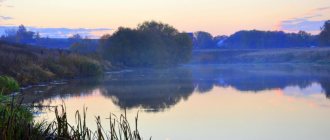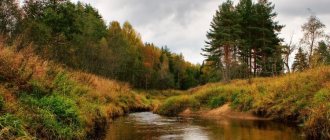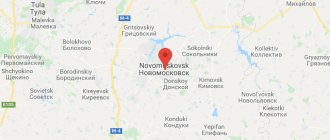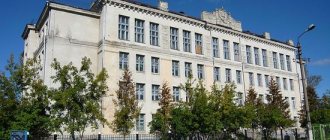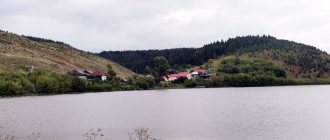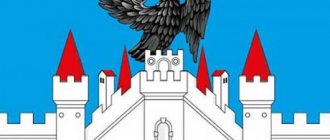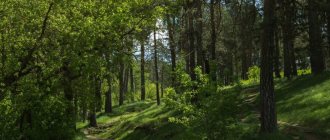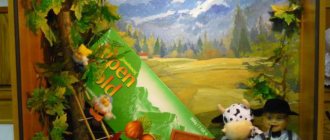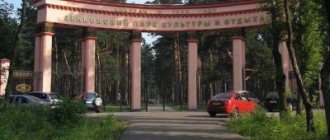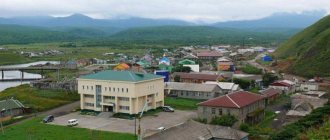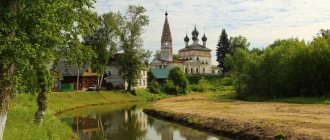Suvorov careers
The Suvorovsky district used to be very rich in minerals, the extraction of which was actively carried out during Soviet times. Our contemporaries have inherited landscapes of unimaginable beauty; in particular, it is worth highlighting the Suvorov quarries, where clay was previously mined.
Today you can no longer find equipment and workers here; instead, your eyes will see a stunning picture of a man-made landscape with hills up to fifty meters high and deep lakes with characteristic blue water.
The Suvorov quarries are a favorite vacation spot not only for local residents; on weekends you can meet a huge number of guests from other regions, including from Tula and Moscow. Therefore, if you plan to spend the weekend here, there is a high probability that all the numerous parking lots will already be occupied.
Cherepetskaya GRES
The main enterprise of the city of Suvorov, it was from here that its history once began. The geographical location of the power plant is far from accidental; when determining it, the architects relied on two main criteria. This is the relatively close location of the power plant to the Moscow Region coal basin and the short distance of the future GRES from the main consumers of electricity, for whom the GRES itself was built.
Today, electricity generated at the station is supplied to the Moscow, Tula, Oryol, Bryansk and Kaluga regions. The Cherepetskaya GRES itself is also interesting because during its construction many problems of varying technical complexity were solved; in 1948, unique equipment was developed and manufactured. It was for the construction of the Cherepetskaya GRES that new grades of heat-resistant steel were developed.
The construction of this power plant was a kind of breakthrough in the entire energy complex of the country. The fuel for the Cherepetskaya GRES to this day is coal from the Moscow region and Kuzbass.
Art Museum
A very young museum, which was opened in 2001, however, despite its rather modest size, it has gained quite a lot of popularity among local art lovers and city guests. The museum mainly displays works by regional artists from different periods.
Particularly noteworthy are the paintings donated to the museum by Igor Aleksandrovich Mamaev, a fairly famous contemporary Russian artist. The opening of an art museum is an event of great importance for such a small town and indicates the high cultural level of the inhabitants.
House-Museum of A. Chekalin
Alexander Pavlovich Chekalin is a native of the Tula region, born in 1925 in the village of Peskovatskoye, Suvorovsky district. Since childhood, he was an excellent shot, was fond of hunting, and knew his way around the nearby forests well. In 1941, as a sixteen-year-old teenager, he joined the ranks of volunteers, and later ended up in a partisan detachment, whose commander was Teterichev.
It was while he was in the partisan detachment that Alexander became a scout; despite his young age, he, along with his elders, participated in collecting information about enemy troops, took part in ambushes and sabotage. One autumn, having caught a cold, Alexander returned to his home; the village head, seeing smoke from the chimney, reported this to the military commandant’s office. Soon the house was surrounded, and the partisan was asked to surrender, to which he responded with fire. After he ran out of ammunition, Alexander was captured, where he was subjected to terrible torture for several days.
Without revealing any information to the enemy, Alexander Pavlovich Chekalin was executed publicly in the city square. The memorial house-museum named after Alexander Chekalin was opened on the initiative of youth and Komsomol members in 1962. It contains the hero’s personal belongings, as well as information stands telling about the activities of the “Advanced” partisan detachment.
Church of the Great Martyr Nikita (Berezovo)[edit]
The foundation of the temple is considered to be 1806, but during restoration work a stone was discovered on which the date June 24, 1700 appears.
Before the revolution, it was the courtyard of the St. Athanasius Convent.
Closed in 1936, the building was used as workshops and a garage.
The dilapidated temple was returned to believers in 1993, and the parish began restoration work.
In 2004, the main altar was consecrated.
There is a holy spring and a house for pilgrims.
Address:
Tula region, Suvorovsky district, village Berezovo, no. 52.
Suvorov Museum of Local Lore
The museum begins its history in 1967; its opening was timed to coincide with the fiftieth anniversary of Soviet power. The museum itself is quite small; it is a small one-story house with three halls. The museum building often hosts meetings with war veterans, various interesting people, and excursions for school students. The exhibition “Provincial Antiquities” is of particular interest. It allows you to plunge into the life of people who lived on this land in the last century. Among the exhibits are many products made of wood, clay, castings, household items, etc.
Most of them were rescued directly by museum workers during historical and everyday expeditions in the Suvorov region. The museum also contributes to the cultural development of the city; many clubs and associations for young people of all ages successfully operate on its territory.
Church of the Intercession of the Blessed Virgin Mary (Suvorov)[edit]
The old brick Church of the Intercession was built in 1806 in the style of late classicism at the expense of the landowner A.G. Kamynina.
With the advent of Soviet power, the temple was closed, and a bakery appeared in its place. The building survived, but was badly damaged.
Parish life began to revive in 2007. A wooden cross and a memorial stone were erected not far from the church building.
Services are held in a temporary building built in 2015 next to the old temple.
Address:
Tula region, Suvorovsky district, city of Suvorov, st. Chkalova.
Victory Memorial
There is probably no city in Russia in which there would not be a monument to the soldiers who died in the Great Patriotic War. In Suvorov there is also a full-fledged memorial complex dedicated to the Feat of Soviet soldiers. It includes a mass grave in which war dead are buried, where townspeople regularly bring fresh flowers.
Eternal flame and stele in honor of the fiftieth anniversary of Victory in the Great Patriotic War. The authors of the memorial complex were: architect Yu.N. Timokhin and Sculptor M.V. Prokofiev. Of particular note is the Alley of Heroes, also included in the Victory Memorial.
You might be interested
- Sights of the city of Kingisepp, photo, description Sights of the city of Kingisepp, photo, description, what to see. Sights of the city of Kingisepp, photos, descriptions, interesting places, hotels, tours. The small town of Kingisepp, located near the border with Estonia, has a rich, interesting, centuries-old history.…
- Sights of Kenya: photos and description Sights of Kenya: photos and descriptions, briefly what to see, what monuments and museums, entertainment to visit, main photos of the best interesting places, prices for hotels and tours. When arriving in any country, you really want...
- Zambia attractions Zambia attractions, Africa, briefly what to see, what monuments and museums, entertainment to visit, main photos of the best interesting places, prices for hotels and tours. The beauty of these places will attract you from the very first minutes...
Suvorov
We continue to drive around the Tula region. And today, together with Masha Kucherova, we are going to Suvorov!
— Suvorovsky district is one of the westernmost points of our region. Moreover, the city itself is very young: it is only 61 years old. Although it is located in one of the oldest areas - Likhvinsky district.
They say that its name comes from the village of Suvorovo, which according to legend was named by the loyal soldiers of the famous commander. They say they loved their leader so much that they asked the friendly village in which they had to stop and spend the night to be named after Alexander Vasilyevich.
True, as the guide of the local history museum Galina Egorovna Shishkova told us, this is just a beautiful legend. But there are no reliable sources that at least somehow confirm this story. But the name became attached to the settlement, and the regional center already received this name in Soviet times.
The local history museum is located in a small one-story wooden house and occupies only a few rooms: compared to museums in other areas, it can even be called tiny. But its hospitality is definitely not inferior to many! What else caught my eye was the respect for all Suvorovites who helped fill it with exhibits. So, almost all things are signed: not only what kind of item it is, but also who gave it to the museum. Things from peasant life, archaeological finds, an exhibition of local artists...
The collection of butterflies is curious: it consists only of those found in the Suvorovsky region. And, as the museum staff said, it’s worth paying attention to how many small butterflies there are, because they are found only in environmentally favorable conditions. So Suvorov can safely be proud of his nature!
Another interesting collection is Russian money from pre-revolutionary coins to Soviet rubles. There are also very rare specimens - banknotes that were in force under the Provisional Government of Russia.
And, of course, the largest space in the museum is given over to a hall dedicated to the Great Patriotic War. Surely, Suvorov’s land gave birth to many Heroes of the Soviet Union. There were four of them in the school in Chekalin alone! Including the famous partisan Sasha Chekalin, who did not surrender to his enemies and died heroically.
The memory of the war years is also alive on the streets of Suvorov: there is a monument dedicated to the 50th anniversary of the Victory, several monuments, an anti-aircraft gun.
Moreover, the anti-aircraft gun is just the beginning; soon various types of military equipment will be lined up along one of the alleys.
Another attraction of the city is the Cherepetskaya State District Power Plant. The only city in the Tula region that has its own “sea” - a huge reservoir within the boundaries of the regional center. The view of it, of course, is the most industrial: on one side there are incredible blue expanses of water all the way to the horizon... ...and tall smoking chimneys starting directly from this horizon. The state district power plant was launched in 1953, and such a powerful power unit was the first in Europe at that time. By the way, in the summer it is officially allowed to swim in the reservoir: this means that experts do not find any violations or harmful elements in the water.
Suvorov is also famous for other water spaces: unusually beautiful blue lakes.
These are empty quarries - workings left after mining and filled with water. Every summer, Blue Lakes attract not only most of the local residents, but also guests from our and neighboring regions. The azure-colored spaces delight everyone not only with unusually clear water, but also with fantastic landscapes around.
The city gave the impression of a clean, well-groomed, cozy and very pleasant place. For example, all the pipes passing over the roads are covered with large posters with declarations of love to Suvorov: they say, there is no better city in the world. The banners were made by the local administration, but the words on them were confirmed by the Suvorov students themselves: endlessly in love with their native places, they almost unanimously told us that no radical changes were needed here, because changes were already happening year after year: they opened a 3D cinema , built a sports and recreation complex, and renovated the Palace of Culture.
Moreover, not only local authorities, but also the residents themselves are involved in positive changes. For example, on Palace Square in front of the Palace of Culture, all the flower beds are planted with flowers by the owner of the flower shop, Galina Obraztsova.
- You better come to us in the summer! - the Suvorovites saw us off. - You will see how everything turns green and blooms here, you will understand why we love Suvorov so much, you will relax on the blue lakes. It’s not easy to live well here, here the soul itself sings!
Want to share your “travel stories”? Write in a personal message to Tatyana Afanasyeva And long live our common endless and cheerful “Gulbari”!
Already published gulbaria for the Tula region:
Aleksin Belev Belev-2 Bogoroditsk Byaki Venev Donskoy Epifan Efremov Krapivna Kolosovo Bald Mountain Novomoskovsk Odoev Perevoloki-Return Torture Tarusa Uzlovaya Manor house Berov Fedyashevo Khruslovka Chekalin Yasnogorsk
Gallery
show all photos

